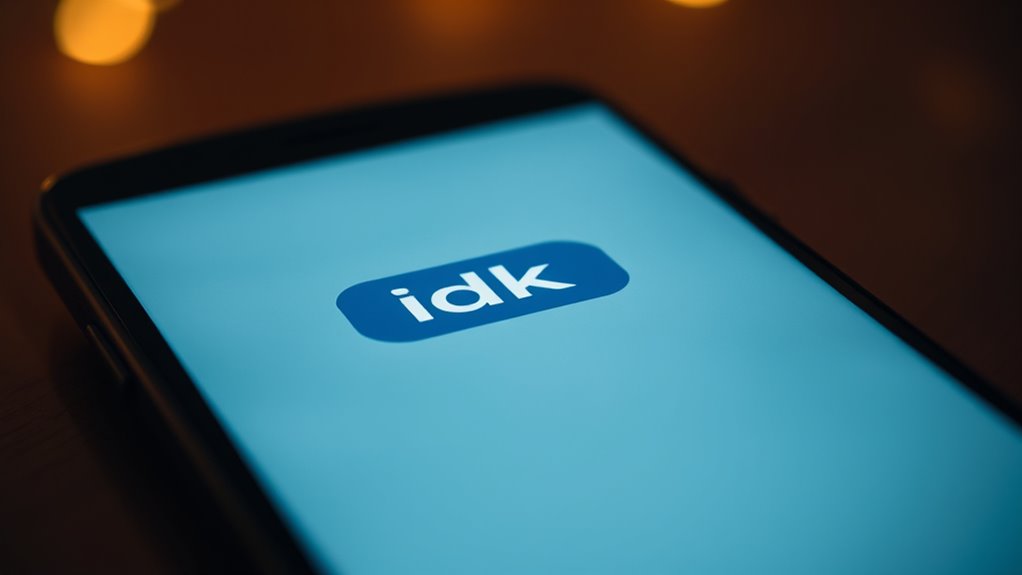“IDK” is a common shortcut in digital conversations that means “I don’t know.” People use it to quickly express uncertainty or lack of information without overexplaining. Keep in mind, it’s part of digital slang that emphasizes brevity, common in texting and online chats. If you want to understand more about its origins, variations, and proper responses, there’s plenty more to discover beyond this quick explanation.
Key Takeaways
- “IDK” is an abbreviation for “I don’t know,” commonly used in texting and online messaging.
- It originated as digital slang to enable quick, informal communication.
- “IDK” expresses uncertainty or lack of information without detailed explanation.
- It is frequently used in casual conversations alongside emojis like 🤷♀ or 🤔.
- Understanding “IDK” helps interpret informal texts and stay current with digital communication trends.
The Origin of “IDK” in Digital Communication

The abbreviation “IDK” emerged as part of the early digital communication landscape, quickly gaining popularity among internet users. It’s a prime example of the history of digital slang, which evolved as people looked for faster ways to communicate online. The concise nature of texting influenced the development of abbreviations like “IDK,” shortening phrases to save time and effort. This linguistic influence of texting reflects a shift toward quick, efficient exchanges, often sacrificing formal grammar for convenience. Over time, these abbreviations became embedded in online conversations, making “IDK” a common part of digital language. Its rise highlights how digital communication shaped language, creating new shortcuts that mirror our need for speed and simplicity in connecting with others. Additionally, the use of abbreviations like “IDK” demonstrates how online communication tools influence language evolution and user interaction.
Common Contexts Where “IDK” Is Used
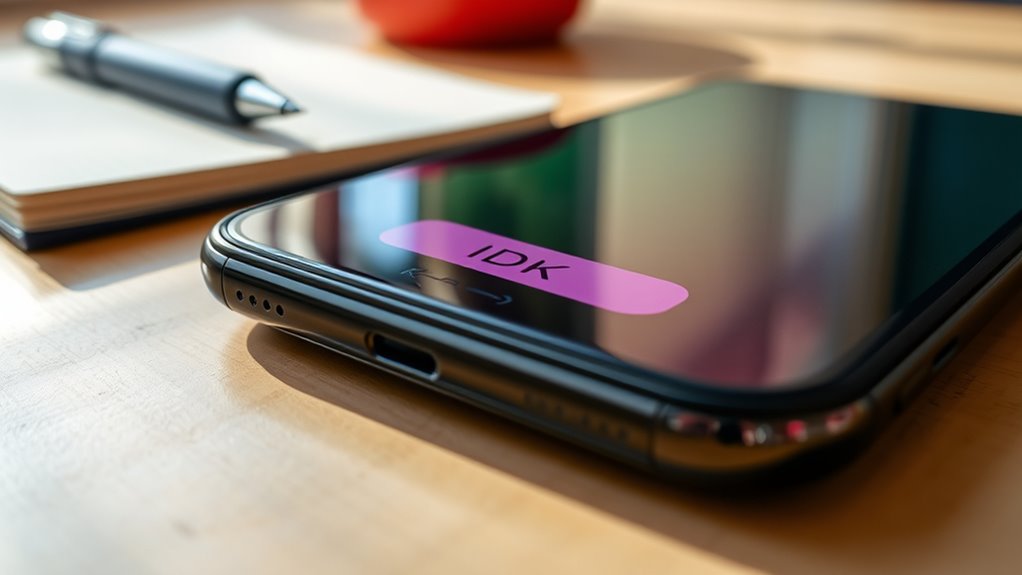
You’ll often see “IDK” in casual conversations and online messaging, where quick replies are common. It’s a simple way to express uncertainty or lack of information without overexplaining. Understanding these contexts helps you see how frequently and naturally “IDK” fits into everyday digital interactions. Additionally, recognizing the abbreviations used can improve your communication clarity.
Casual Conversations
Ever wondered when people commonly use “IDK” in everyday chats? In casual conversations, “IDK” often appears when you’re unsure about a topic or don’t have an answer. It helps keep the tone light and informal, making conversations flow smoothly without feeling too serious. You’ll notice people sometimes add emojis like 🤷♀ or 🤔 to emphasize uncertainty or a relaxed attitude. Using “IDK” in these contexts signals that it’s okay not to have all the details or to admit you’re unsure. It’s a quick way to acknowledge ignorance without overexplaining. In daily chats, “IDK” helps maintain a tone of casualness, showing you’re just being honest without any pressure or formality. Additionally, understanding common abbreviations like “IDK” can improve your communication in digital conversations.
Online Messaging
Have you noticed how often people type “IDK” when messaging online? It’s a common way to show uncertainty quickly and casually. Online messaging often involves emoji usage to add tone or emotion, making conversations clearer. You’ll see “IDK” in chats about plans, opinions, or decisions, reflecting the slang evolution from formal language. For example, someone might reply with “IDK 🤷♀” to express confusion or indecision. It’s also used in group chats to save time or avoid lengthy explanations. Sometimes, “IDK” is paired with emojis to soften the message or convey humor. This shorthand keeps conversations flowing smoothly, especially when clarity is less critical. Overall, “IDK” is a versatile, informal way to communicate uncertainty in digital conversations.
Variations and Similar Acronyms to “IDK”

You might come across other acronyms that express uncertainty or similar sentiments to “IDK.” These variations and synonyms can help you understand different ways people communicate hesitation or lack of knowledge. Exploring these options can enhance your grasp of casual texting language. Understanding independent sellers and their communication styles can also provide context for why certain abbreviations are popular in informal exchanges.
Variations and Similar Acronyms to “IDK”
Are there other ways to express uncertainty or ask for clarification besides “IDK”? Absolutely. As slang evolves, new abbreviations and acronyms emerge, reflecting digital literacy and changing communication styles. These variations help keep your conversations fresh and relatable. For example:
- “No clue” (often shortened to “Ncl” or just “N”)
- “Haven’t a clue” (“HAC”)
- “Not sure” (“NS”)
- “Dunno” (a common slang version of “don’t know”)
- “IDK, honestly” (adding emphasis)
These alternatives can convey uncertainty in different contexts, showing your grasp of slang evolution. Using diverse expressions also makes your digital literacy sharper, helping you stay in sync with online trends. Additionally, understanding different slang terms can aid in interpreting various online conversations and texts more effectively.
Common Synonyms
Building on the various ways to express uncertainty, there are several common synonyms and abbreviations similar to “IDK” that you might encounter or use. In digital slang, people often turn to phrases like “No idea” or “Not sure” for clarity. Shortcuts like “N/A” (not applicable) can also indicate uncertainty or lack of knowledge. Emoji replacements are popular too; you might see 🤷♂ or 🤷♀ to visually express “I don’t know.” These alternatives help keep conversations quick and casual. Some users also adopt abbreviations like “IDK4” (IDK for) or combine emojis with text to add personality. Recognizing these variations can improve your understanding of online chats and make your responses more versatile in digital conversations. Additionally, when seeking quick reassurance or information, people sometimes use abbreviations like “IDK” alongside visual cues such as question mark emojis to emphasize uncertainty.
How to Respond When Someone Uses “IDK”

When someone responds with “IDK,” it’s often helpful to acknowledge their uncertainty without pressuring them for an immediate answer. Responding politely can foster understanding and patience. You might say,
- *”That’s okay, take your time.”*
- *”No worries, let me know if you find out.”*
- *”I understand, it’s a lot to contemplate.”*
- *”Thanks for letting me know.”*
- *”Whenever you’re ready, I’ll be here.”*
Being mindful of user consent management and respecting their comfort level can help maintain a positive interaction. These responses express uncertainty while showing respect and patience. They create a safe space for open communication, avoiding any pressure. Responding politely helps maintain the flow of conversation and encourages honesty, making it easier to navigate uncertain moments smoothly.
The Cultural Significance of Abbreviations Like “IDK”
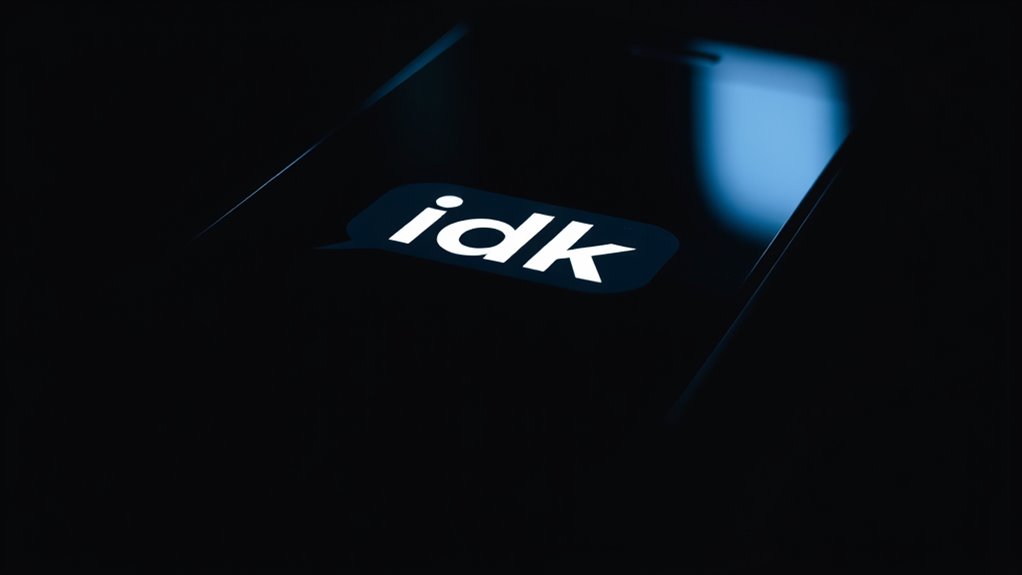
Abbreviations like “IDK” have become more than just shorthand; they carry cultural significance that reflects how people communicate in the digital age. They influence societal perceptions of language, making communication quicker and more informal. These abbreviations shape cultural influence by creating shared symbols that transcend boundaries, fostering a sense of community among users. They also reflect evolving societal norms, emphasizing efficiency over formality. As you see “IDK” and similar terms everywhere, they symbolize a shift toward more casual, immediate interactions. This change impacts how society perceives communication, valuing brevity and authenticity. Additionally, these abbreviations often emerge from digital communication trends, illustrating how technology influences language evolution. Ultimately, abbreviations like “IDK” are more than abbreviations—they’re cultural markers that mirror modern communication’s fast-paced, interconnected world.
Differences Between Formal and Informal Communication
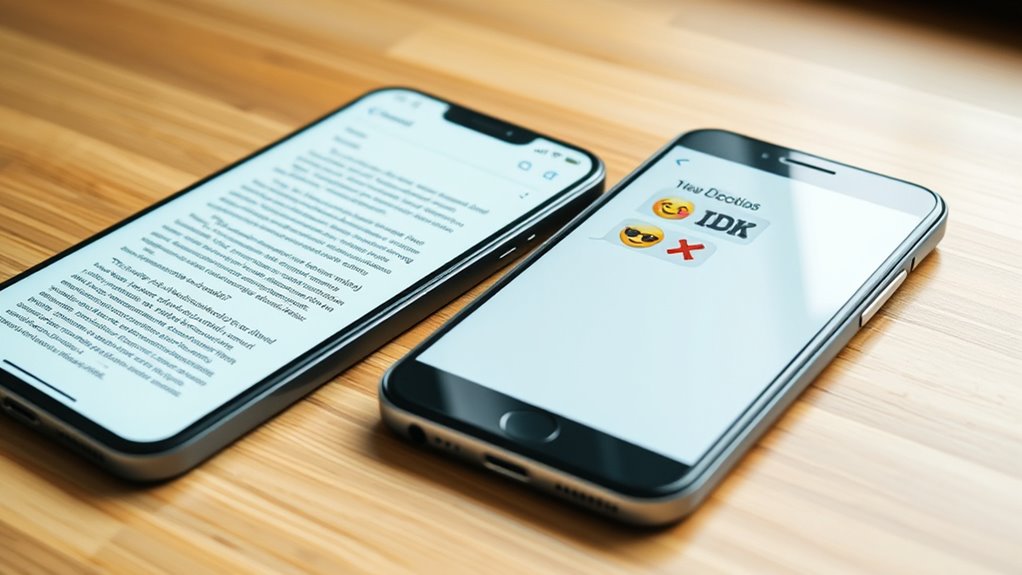
Formal and informal communication serve different purposes and follow distinct conventions. When you engage in professional communication, you prioritize clarity, respect, and adherence to digital etiquette. You use complete sentences, proper punctuation, and a respectful tone. In contrast, informal communication is more relaxed and spontaneous, often involving slang, abbreviations, and emojis. Visualize these differences:
Formal communication emphasizes clarity and respect, while informal chats are relaxed and spontaneous.
- A polished email with proper greetings and signatures
- Casual texts with abbreviations like “IDK” and emojis
- Business meetings focusing on clarity and professionalism
- Chatting with friends using slang and informal language
- Formal reports with structured formatting and citations
Understanding these differences helps you choose the right approach for each situation, ensuring your message is appropriate and effective. Whether in personal or professional contexts, mastering these distinctions enhances your communication skills.
The Impact of Texting Abbreviations on Language Skills
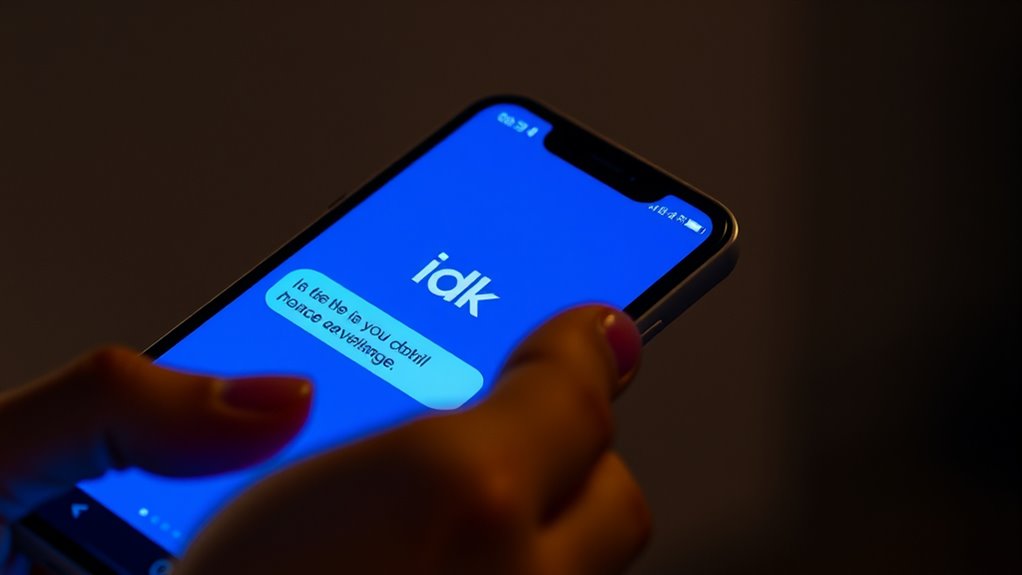
As texting abbreviations like “IDK” become more commonplace, they influence how people develop and use language in everyday communication. These shortcuts can impact your language development by simplifying expression, sometimes reducing vocabulary richness or grammatical accuracy. While they boost digital literacy by making online interactions faster and more efficient, they may also lead to misunderstandings or sloppy writing habits if overused. You might find yourself relying on abbreviations, which can hinder your ability to communicate clearly in formal settings. Additionally, frequent use of such slang can alter perceptions of professionalism and may affect your language skills over time. However, when used appropriately, texting slang can enhance your digital communication skills without sacrificing your overall language proficiency. Striking a balance ensures you stay effective in both informal chats and more structured, professional conversations.
Tips for Deciphering Other Texting Acronyms

Deciphering texting acronyms can seem challenging at first, but with some simple strategies, you can quickly understand even the most unfamiliar shortcuts. To keep up with language evolution and slang adoption, try these tips:
Decoding texting acronyms is easier with these simple strategies and staying updated on slang trends.
- Context clues: Pay attention to the conversation to infer meanings.
- Use online tools: Websites and apps can decode unknown acronyms instantly.
- Ask directly: Don’t hesitate to ask the sender for clarification.
- Learn common patterns: Recognize abbreviations like “LOL” or “BRB” that appear frequently.
- Stay updated: Follow social media trends to catch new slang and acronyms early.
- Familiarize yourself with tech terms: Understanding headphone connections and other device-related terminology can help interpret tech-related texts more easily.
The Evolution of Texting Language Over Time
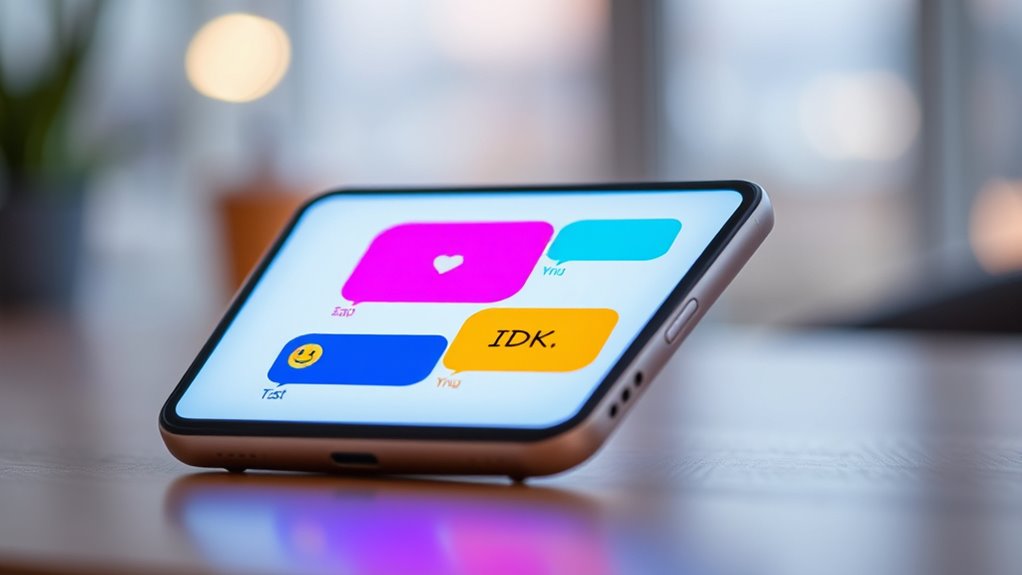
Texting language has changed rapidly over the past decade, reflecting shifts in technology, culture, and communication habits. The history of texting slang shows how abbreviations and acronyms evolved from simple shortcuts to complex digital expressions. You’ve seen how the evolution of digital language adapts to new platforms and user needs, making conversations faster and more efficient. Here’s a quick look at some key stages:
| Era | Features | Examples |
|---|---|---|
| Early days | Basic abbreviations | LOL, BRB |
| Rise of smartphones | Emojis and autocorrect | 😊, OMG |
| Social media | Hashtags, memes | #TBT, Viral |
| Modern trends | GIFs, TikTok slang | FYP, Yeet |
This evolution continues, shaping how you communicate daily. Additionally, the integration of linguistic abbreviations has played a significant role in making digital conversations more concise and expressive.
Frequently Asked Questions
How Is “Idk” Pronounced in Conversation?
You pronounce “IDK” as “ay-dee-kay,” emphasizing clear pronunciation for smoother conversation. Since it’s a spoken abbreviation, you want to guarantee your pronunciation clarity so others understand you easily. When you say it aloud, keep it natural and quick, just like other common spoken abbreviations. Practicing saying “IDK” this way helps you communicate more effectively in casual chats or voice messages, making your meaning clear effortlessly.
Are There Regional Differences in Using “Idk”?
You might find that regional slang and dialect variations influence how people use “IDK.” In some areas, folks might shorten it further or add local expressions, making it feel like a secret handshake. While “IDK” is pretty universal online, in spoken conversations, regional differences shape its tone and frequency. Think of it as a linguistic map, where each region adds its own color and flavor to this common abbreviation.
Can “Idk” Be Considered Inappropriate in Professional Settings?
You should avoid using “IDK” in professional settings because it can seem too informal and undermine workplace professionalism. In formal communication, it’s better to write out “I don’t know” to maintain clarity and respect. Using abbreviations like “IDK” may be acceptable in casual conversations, but in the workplace, it’s important to project a polished and professional image by choosing proper language.
How Has “Idk” Evolved With New Messaging Platforms?
Like a chameleon shifting colors, “idk” has adapted to new messaging platforms, becoming more than just a simple abbreviation. As texting abbreviations and slang evolve, it now often appears with emojis or in quick-fire chats, making it feel more casual and spontaneous. You might see it in group chats or social media comments, where brevity reigns. Its evolution reflects how language adapts to keep pace with our fast-moving digital conversations.
Are There Any Emojis Commonly Paired With “Idk”?
You’ll often see emojis paired with “IDK” to enhance your texting etiquette and express uncertainty more clearly. Common emoji combinations include the shrug emoji 🤷♂ or 🤷♀, which emphasize confusion or lack of knowledge, and the facepalm 🤦♂ or 🤦♀, showing frustration or disbelief. These emojis help convey tone and emotion, making your messages more engaging and less ambiguous in digital conversations.
Conclusion
Just like a shortcut in a busy city saves you time, abbreviations like “IDK” make texting quicker and easier. But remember, while these shortcuts help us communicate faster, they shouldn’t substitute clear understanding. Think of them as a map—useful, but always guarantee you’re on the right path. Embrace the evolution of language, but stay mindful that true connection comes from clarity, not just abbreviations.
